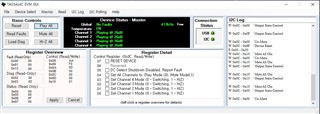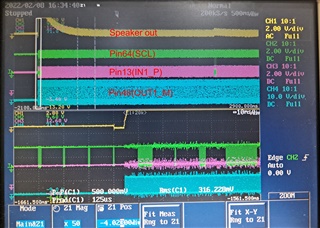Dear. Experts.
I am using the TAS5414CQ1(silked on chip as XTAS5414CQ1) as the master.
I have some problems.
1. In the Play All or Mute All state, pop noise occurs when controlling individual channels as shown below.(and vice versa)
This is also happening on your EVM board.
W 0x0C 0x00 -> 0x0C 0x03
W 0x0C 0x00 -> 0x0C 0x0C
W 0x0C 0x00 -> 0x0C 0x0F
W 0x0C 0x10 -> 0x0C 0x03
W 0x0C 0x10 -> 0x0C 0x0C
W 0x0C 0x10 -> 0x0C 0x0F
At this time, the waveform of the mute pin is as the attached file. Is this waveform normal?
I have attached my setting values and circuit diagram. Please advise on how to avoid pop noise.
2.Separation is not good in our product.
For example, when 1 KHZ signal is connected to R CH and no signal to L-CH, the signal of RCH is output to L-CH with low sound.
When checking the L-CH input with the scope, there is no signal interference, but you can hear a small sound with the SPEAKER.
DIGITAL AMP seems to be interfering. Could you please review what could be the cause?
Thank you.








